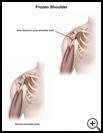
Frozen Shoulder
________________________________________________________________________
KEY POINTS
- A frozen shoulder is stiffness and pain that makes it hard to move your shoulder, usually caused by scar tissue that forms after an injury or surgery.
- Treatment may include medicine, physical therapy, or surgery.
- After you have had an injury to your shoulder, do rehabilitation exercises as they have been prescribed. If you feel that you are losing range of motion in your shoulder, see your healthcare provider.
________________________________________________________________________
What is a frozen shoulder?
A frozen shoulder is stiffness and pain that makes it hard to move your shoulder. The effects of a frozen shoulder can be long lasting and can get worse without treatment.
What is the cause?
A frozen shoulder usually starts after an injury or surgery that causes pain and keeps you from being able to move your shoulder for several weeks. Limited movement can cause scar tissue to form in your shoulder joint.
You may be at higher risk for a frozen shoulder after an injury or surgery if you have a medical condition such as diabetes, thyroid disease, heart disease, or arthritis.
What are the symptoms?
Symptoms may include:
- Pain in your shoulder that comes on slowly over several weeks to months
- After having pain for several weeks, you may have stiffness or trouble moving your shoulder, such as not being able to lift your arm above your head, scratch your back, reach your back pocket, or put on a bra. You may have trouble sleeping.
How is it diagnosed?
Your healthcare provider will ask about your symptoms and medical history and examine you. Tests may include:
- X-rays
- MRI, which uses a strong magnetic field and radio waves to show detailed pictures of the shoulder
How is it treated?
Even without treatment, the pain and stiffness of a frozen shoulder may gradually go away after a few years. Treatment can help the symptoms. Your provider may recommend pain medicine, or give you a shot of a steroid medicine into your shoulder joint to help with pain and swelling. You may need to see a physical therapist to learn stretching exercises.
If your shoulder doesn’t get better with exercises and medicine, you may need a procedure to break up the scar tissue in your shoulder. You will be given general anesthesia to relax your muscles and keep you from feeling pain. You will be asleep during the procedure. Your provider will move your shoulder in many directions to break up the bands of scar tissue.
You may need arthroscopic surgery to remove scar tissue. Arthroscopy uses a lighted tube with a camera to see inside your shoulder. Your provider can put the scope and tools through small cuts to repair your joint.
How can I take care of myself?
Follow the full course of treatment prescribed by your healthcare provider. In addition:
- Put an ice pack, gel pack, or package of frozen vegetables wrapped in a cloth on the injured area every 3 to 4 hours for up to 20 minutes at a time.
- Take nonprescription pain medicine, such as acetaminophen, ibuprofen, or naproxen. Read the label and take as directed. Unless recommended by your healthcare provider, you should not take these medicines for more than 10 days.
- Nonsteroidal anti-inflammatory medicines (NSAIDs), such as ibuprofen, naproxen, and aspirin, may cause stomach bleeding and other problems. These risks increase with age.
- Acetaminophen may cause liver damage or other problems. Unless recommended by your provider, don't take more than 3000 milligrams (mg) in 24 hours. To make sure you don’t take too much, check other medicines you take to see if they also contain acetaminophen. Ask your provider if you need to avoid drinking alcohol while taking this medicine.
- Do the exercises recommended by your healthcare provider.
Ask your provider:
- How long it will take to recover
- If there are activities you should avoid and when you can return to your normal activities
- How to take care of yourself at home
- What symptoms or problems you should watch for and what to do if you have them
Make sure you know when you should come back for a checkup. Keep all appointments for provider visits or tests.
How can I help prevent a frozen shoulder?
After you have had an injury to your shoulder it is important that you do not limit your shoulder motion for any longer than you have to. This is even more important if you have diabetes, arthritis, or heart disease.
Do shoulder rehabilitation exercises as they have been prescribed. If you feel that you are losing range of motion in your shoulder, see your healthcare provider.

